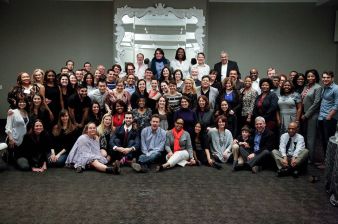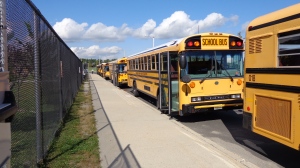1.) Be ready for them. Know their names, Have the room arranged for them. There is one thing that I do every year that sends a big message. When I arrange my room I always incorporate one or two extra desks into the set up. It depends on how many are on my list but I always add one or two. Then when a new student arrives, they usually do, instead of griping that my perfect arrangement is now difficult to manage I simply turn and say, “We have been waiting for you, come on in and let’s get started.” Children are believers and literal thinkers at the age of 6 or 7. They will feel honored instead of being a burden. This year I had 21 students but my room is set up in 6 groups of 4. Three sections have an extra desk. Continue reading
Great Teaching
No Teacher Leader Left Behind!
Why the New ESEA Must Contain Teacher Leadership
In 1965, President Lyndon B. Johnson signed the Elementary and Secondary Education Act (ESEA) with his former teacher and a group of Mexican Americans, his former students, standing behind him. This legislation was born out of Johnson’s deeply held belief that not all students were getting access to the American Dream: “As the son of a tenant farmer, I know that education is the only valid passport from poverty.” President Johnson’s personal experiences – teaching in a segregated school during college and then teaching high school prior to his political career – led him to action in passing this law that would have an enormous and lasting impact on education.
I Have Failed and I’m Proud of It!
So much has been said lately in education regarding perseverance and grit. The work of Angela Duckworth and Carol Dweck has been widely embraced. As educators, we don’t always have opportunities to model these traits, but pursuing National Board Certification has given me this opportunity. In 2012, after teaching second grade for 8 years, I was selected as a National Teacher Fellow with America Achieves Fellowship for Teachers & Principals. At the spring conference they asked all the National Board Certified Teachers/Principals to gather for a photo. I looked upon that group and was inspired. On that cold day in February in the Memphis Marriott I decided I wanted to be in that picture.

Building Student Relationships that last past June
There has been a lot of research on the importance of relationship building and its impact on learning. Studies and anecdotal evidence indicate that when students experience a supportive relationship of mutual respect with their teacher they are more engaged in their learning. A study was conducted by German researcher named Liselotte Anhert and her colleagues to see if friendly supportive pre-school teachers had an impact on the academic performance of their students. Their research provided evidence that students with supportive teacher relationships did better than those who did not have them. In the online journal Parenting Science an article titled, Student-teacher relationships: Does it really matter if students and teachers like each other? © 2013 Gwen Dewar, Ph.D.
“To test this, the researchers have taken photographs of all the children’s teachers. And just before being given a new problem to solve, each child is shown her teacher’s face. The image appears only for a split second, a time span so brief the kids aren’t even aware of what they’ve seen. It’s subliminal. But it has an effect, because the kids who have close, affectionate teacher relationships – as opposed to distant ones — end up solving many problems faster (Ahnert et al 2012).”
The German researchers followed the students into their early primary learning years and found other interesting connections between the relationship and hormone fluctuation related to stress levels. Students with better relationships experienced less fluctuation. The power that a relationship between a teacher and student can have on a student is extremely important because it can impact future learning in addition to what goes on during the year they spend in the same classroom.
“Then there are the big, longitudinal studies, studies showing that kids who experience supportive student-teacher relationships in the early years develop fewer behavior problems years later, and show more engagement in the classroom”

